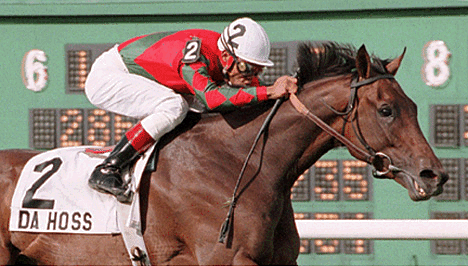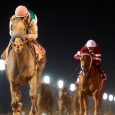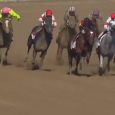(Editor’s note: This is an update of an article originally published in 2010.)

Michael Dickinson (photo via www.racingtips.com)
November 7, 1998… a date that will live in horse racing infamy.
On that Saturday, in the shadow of the historic Twin Spires of Churchill Downs in Louisville, Kentucky, an even greater shadow descended upon the Sport of Kings — one that I believe still envelops it today.
The seventh race that afternoon was the $1 million Breeders’ Cup Mile and, as usual, it drew a stellar international cast that included 1997 U.S. Horse of the Year Favorite Trick, Canadian champ Labeeb and Desert Prince, a three-time Group 1 winner at eight furlongs in Europe.
But none of those classy steeds won. Instead, a six-year-old bay gelding that had raced exactly once in the past two years outdueled a determined Hawksley Hill down the stretch to prevail by a short head. With the hard-fought victory, Da Hoss became just the third horse (at the time) to capture the BC Mile twice.
Yet, in the aftermath of the race, Da Hoss, a brilliant animal that won 12 of 20 lifetime starts and was off the board just once — in the 1995 Breeders’ Cup Sprint — was not the main topic of conversation. That honor belonged to the gelding’s trainer, Michael Dickinson.
“November 7, 1998 will be remembered as the day Michael Dickinson pulled off one of the great training feats in American racing history,” opined Mark Simon of the Thoroughbred Times.
“I think he’s a genius squared. He’s a double genius. He’s a genius in a mind,” gushed race caller Trevor Denman.
“The most acclaimed horsemen in American history — Charlie Whittingham, Woody Stephens, ‘Sunny’ Jim Fitzsimmons, Ben Jones — never did anything like this,” added Andy Beyer, creator of the Beyer speed figures that appear in the Daily Racing Form.
And it didn’t end there.
NBC’s Tom Durkin called Da Hoss’ victory the “greatest comeback since Lazarus,” while Steve Haskin from Bloodhorse magazine claimed “Dickinson proved once and for all he is indeed a genius.”
Heck, one gets the feeling that had Albert Einstein still been alive he would have solicited Dickinson’s help in developing his unified field theory — or asked Dickinson to take 15 minutes and do it himself.
Look, I’m not trying to begrudge Dickinson his moment in the sun. After all, the man was a fantastic steeplechase trainer too. He proved that in 1983 when he sent out the top five finishers in the Cheltenham Gold Cup, an accomplishment that earned him a place in the Guinness Book of World Records and was recently voted the greatest training feat of all time by online readers of the Racing Post. Still, I can’t help but wonder what effect Dickinson’s — I mean, Da Hoss’ — victory ultimately had on the sport. After all, few with access to race replays and a stopwatch would argue that Secretariat’s three Triple Crown efforts, which included two track records and one world record, were among the finest in history. Yet, I don’t recall Lucien Lauren being hailed as “a genius squared.”
Then too, Secretariat wasn’t coming off a two-year layoff. The beast that Time magazine featured in a 1973 cover story was a “tremendous machine,” the kind of colt that made “grown men weep,” according to New York Post columnist Larry Merchant.
And he raced.
As a two-year-old, Secretariat started nine times; as a sophomore, he heeded the call to post 12 times. In other words, Big Red pretty much trained himself. Unlike Dickinson, who had to get Da Hoss ready to run one of the biggest races of his life solely on workouts and a single allowance prep, Lauren simply pointed Secretariat in the direction of the starting gate and said, “go.” Or so it would seem.

Da Hoss (Photo via www.angelfire.com)
But did Dickinson’s incredible achievement and the accolades he received for it create a new training paradigm, one that put a premium on workouts and other forms of conditioning rather than racing as a means of getting in shape?
I believe it did, but I was curious what the legend himself had to say about the matter, so I asked him.
“Anyone who believes that other trainers have tried to run their horses less because Da Hoss won the ‘98 Breeders Cup after a two-year layoff and only one race, needs their head examined by a really good man,” Dickinson responded.
“Da Hoss won the ‘98 Breeders Cup because he was the best horse in the race. He loved his training and had great courage combined with the fact that the facilities at Tapeta would be vastly superior to any racetrack in the USA.” (Tapeta is an artificial training and racing surface that Dickinson created and used to market full-time.)
Nonetheless, I wasn’t convinced that Dickinson was right regarding his own legacy and that of his most famous pupil (I’m stubborn that way). So, in between therapy sessions, I did some research. What I found is that from the inception of the Breeders’ Cup Mile in 1984 until 1997 — the year prior to Da Hoss’ miracle win — Mile champs averaged 6.9 total starts in the year of their victory. After 1998, that average dipped to 6.0. Of course, this hardly proves my hypothesis, nor does it alter the power to which Dickinson’s genius should be raised, but it is food for thought.
Before I could call my psychiatrist with the good news, however, Dickinson explained this decline.
“It is a well-known fact that the modern horse is more delicate than its predecessors,” he informed me. “Some of the sales consignors at Kentucky told me some of the European agents don’t come shopping for yearlings in the USA anymore because many of them were three-generation medication horses.”
While I would hardly disagree that medication — legal or otherwise — has had a detrimental effect on the game, we’re talking about 30 years here (since 1984). The only time I’ve seen a gene pool erode that quickly is on MTV, where I understand “The Real World: Petri Dish” is scheduled to start shooting this fall.
To me, the weakening-of-the-breed theory has become the ultimate chicken and egg argument — a self-fulfilling prophecy of doom and gloom. Despite evidence that clearly shows consistent racing does not hinder performance (under normal circumstances) — and in fact may help it — layoffs have become the norm, the “freshened” horse the standard. It begs the question: Why do so many of today’s top trainers feel the need to “baby” their stock? Any thoughts Mr. Dickinson?
“There are many excellent trainers in America who know how to train a horse and it is certainly not correct for some bloggers who don’t know the difference between a fetlock and a forelock to tell trainers how to condition their horses,” Dickinson said.
Ouch. Maybe I’m talking out of my fetlock here, but isn’t that a bit harsh? After all, I didn’t chide Dickinson when he took a crack at handicapping and called Zenyatta “very overrated” prior to her win in the 2009 Breeders’ Cup Classic.

Dr. Larry Bramlage (photo via www.roodandriddle.com)
One guy who does know the difference between a fetlock and a forelock, however, is veterinarian Dr. Larry Bramlage. And, based on statements he made at The Jockey Club Annual Round Table Conference in 2010, the good doctor is on my side.
“There is no indication … that in the last 30 years the thoroughbred has become less able to sustain training,” Dr. Bramlage stated. “And the data indicates the aged starters have been and are currently making up a consistent third of the racing population.”
After pointing out that the average racehorse made 0.93 fewer starts in 2007 than it did in 1997 (interesting date range, huh?), Dr. Bramlage attributed the decrease to the “appearance of the mega-stables and an increased emphasis on trainer statistics.”
“Horses don’t run if they don’t have a good chance to win,” Dr. Bramlage said, “whether they come from a large or a small stable, but large stables magnify the effect.
“So most of the decline in career starts can be attributed to these factors of management of the horse. The horse itself probably plays some role, but the data shows it is likely a lesser role.”
Indeed. Still, as long as owners and trainers continue to cling to the notion that thoroughbreds are becoming increasingly more fragile, I doubt much will change on the racing front. Leonardo da Vinci said it best: “The greatest deception men suffer is from their own opinions.”
Now that’s genius.



